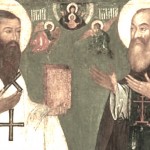Owing to both papal and canonical disapproval, beards have been underrepresented in the Latin church. Whereas Orthodox hierarchs have long been barbate and bushy, Latin clerics have typically preferred naked cheeks and smooth chins. The Catholic Encyclopedia offers some background for this bias, but it’s fun to consider a period when this prejudice was sorely tested.
By my reading of things, it all starts with the papal election of 1455. The conclave had whittled down its options, and one of the finalists was a Greek cardinal named Basilios Bessarion (1403-1472). Though he had abandoned the eastern church, he retained the Orthodox habit of wearing his beard long and full.
At one point in the final deliberations a French cardinal jumped to his feet and implored his fellow cardinals to reject Bessarion. “Shall we give a Greek pope to the Latin Church?” he started. “Shall we make a neophyte the supreme head? Bessarion has not yet shaven his beard. . . .” That Jesus and the apostles likely had beards must not have occurred to him. Said Bessarion’s opponent in so many words, We can do better.
In his place, the conclave elected the beardless Callixtus III. Born Alfons de Borja, the Italians knew this Spanish cardinal as Alonzo Borgia. The Borgias are sometimes considered Europe’s first crime family. While Callixtus’ reputation was faultless, his nephew later became pope and is primarily remembered for his many illegitimate children and general corruption — though he did possess a pristinely hairless chin.
More than even the papacy, Bessarion’s beard might have also cost him his life. Remaining active in church affairs following the conclave, he suffered another embarrassment while on embassy to France. During a meeting with Louis XI, the king took a disliking to him and yanked his beard while saying that Greeks are partial to their barbarism — surely the kind of pun that garnered chuckles from the court. For his part, Bessarion was so humiliated by the indignity that he died on the way home.
But poor Bessarion was just a man before his time!
About fifty years after the conclave Pope Julius II (1443-1513) stopped shaving for a couple of years to mourn the wartime loss of a city. The habit skipped a couple of popes but Clement VII (1478-1534) also let one grow when Rome was sacked in 1527 by Holy Roman Emperor Charles V.
Some criticized Pope Clement for his beard, which he maintained until he died. But to his defense swung the humanist Pierio Valeriano who penned Pro Sacerdotum Barbis, which as the title of the tract suggests is about priests and their beards. If your Latin is any good, you can read it here. My Latin isn’t, and so I rely instead on the summary provided by Kenneth Gouwens in Remembering the Renaissance:
Tellingly, the Pro sacerdotum barbis locates the causes of Rome’s sufferings in the “feminine” delicacies of the Roman clergy, which had provoked the wrath of God and threatened to do so again. Because of the excesses, God “commanded that our goods be taken from us, that our rather sumptuous houses be either brought down or burned, and that the many delights of our too-wanton minds be plucked away from us.” The wearing of beards, then, signifies the effort to reform the “effeminacy” into which the clergy had slipped. (p. 151)
Charles V, after all, had a beard.
Valeriano’s treatise did the job. The beard was back from exile — but only for a while. Portraits of popes from Clement VII to Urban VIII (1568-1644) feature full beards, some quite bushy and bristly. The preferred style shrank to a narrow goatee and mustache with Innocent X (1574-1655) and stayed that way until Innocent XII (1615-1700) took the fashion with him to the grave. No pope has worn a beard since.
Feel free to make more than is warranted of the correlation between that sad fact and the world going to hell in a hand basket during all the many years that followed.











